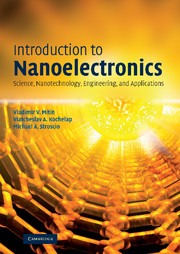Book contents
- Frontmatter
- Contents
- Preface
- List of notation
- 1 Toward the nanoscale
- 2 Particles and waves
- 3 Wave mechanics
- 4 Materials for nanoelectronics
- 5 Growth, fabrication, and measurement techniques for nanostructures
- 6 Electron transport in semiconductors and nanostructures
- 7 Electrons in traditional low-dimensional structures
- 8 Nanostructure devices
- Appendix: tables of units
- Index
3 - Wave mechanics
Published online by Cambridge University Press: 05 June 2012
- Frontmatter
- Contents
- Preface
- List of notation
- 1 Toward the nanoscale
- 2 Particles and waves
- 3 Wave mechanics
- 4 Materials for nanoelectronics
- 5 Growth, fabrication, and measurement techniques for nanostructures
- 6 Electron transport in semiconductors and nanostructures
- 7 Electrons in traditional low-dimensional structures
- 8 Nanostructure devices
- Appendix: tables of units
- Index
Summary
Introduction
In this chapter we discuss the basic physical concepts and equations related to the behavior of particles in the nanoworld. We introduce the Schrödinger wave equation for particles and determine the ways to calculate observable physical quantities. We find that, in wave mechanics, the motion of a particle confined to a finite volume is always characterized by discrete values of the energy and standing-wave-like wavefunctions, i.e., such a motion is quantized. While motion in an infinite space (i.e., free motion) is not quantized and is described by propagating waves, the energy of the particle is characterized by a continuous range of values.
Keeping in mind the diverse variants of nanostructures, by using wave mechanics we analyze some particular examples, which highlight important quantum properties of particles. Many of the examples analyzed can serve as the simplest models of nanostructures and will be exploited in following chapters to understand the fundamentals of processes in nanoelectronics.
The Schrödinger wave equation
From the previous chapter, we conclude that nanosize physical systems are quantum-mechanical systems, inasmuch as their sizes are comparable to typical de Broglie wavelengths of the particles composing these systems. In dealing with quantum-mechanical systems, one aims at determining the wavefunction of a single particle or of the whole system. As we will demonstrate in the subsequent discussion, knowledge of the wavefunction in quantum mechanics is sufficient to describe completely a particle or even a system of particles.
- Type
- Chapter
- Information
- Introduction to NanoelectronicsScience, Nanotechnology, Engineering, and Applications, pp. 33 - 64Publisher: Cambridge University PressPrint publication year: 2007



